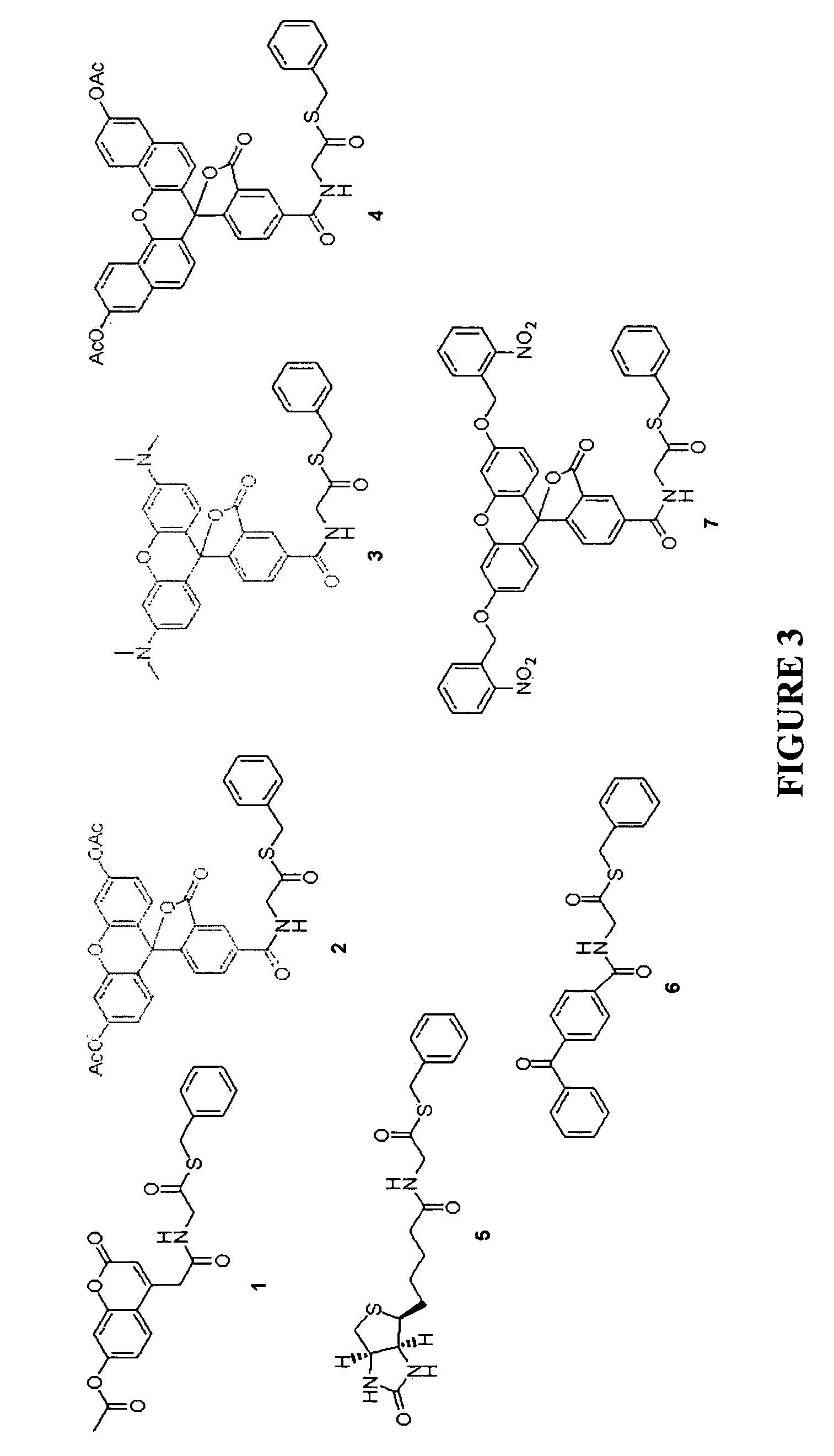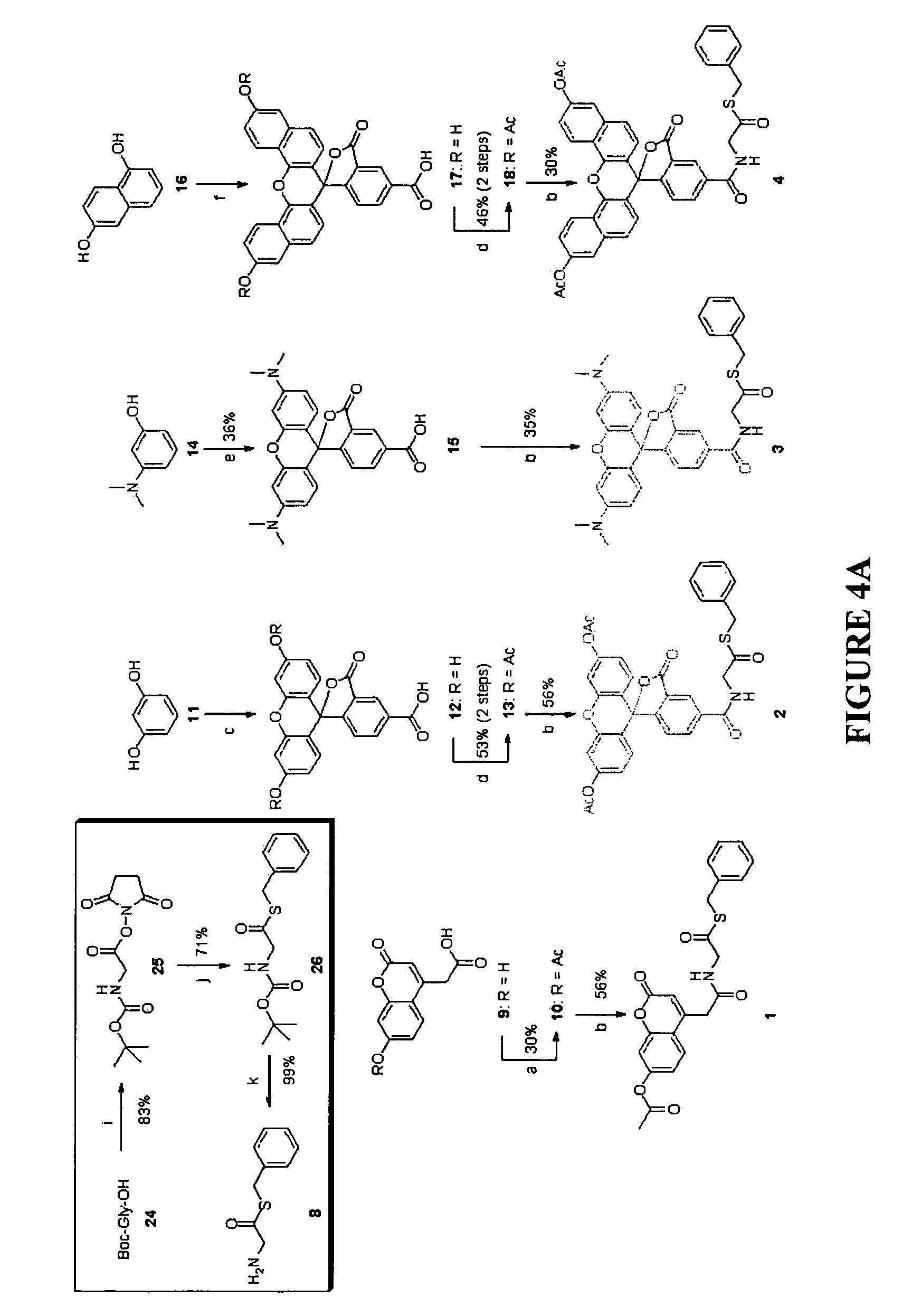Site-specific labelling of proteins
a protein and site-specific technology, applied in the field of protein labeling methods, can solve the problems of limiting the number of colours that can be used to “tag” a protein in vivo, affecting the biological and cellular activities of the target protein, and limiting the strategy of labelling a target protein
- Summary
- Abstract
- Description
- Claims
- Application Information
AI Technical Summary
Benefits of technology
Problems solved by technology
Method used
Image
Examples
example 1
Synthesis of Membrane-Permeable Thioester Containing Probes
[0073]A total of 7 different thioester-containing probes were synthesized for in vivo protein labelling at N-terminal cysteines, the various structures of which are depicted in FIG. 3. Probes 1 to 4 are fluorophore-containing thioesters; 5 and 6 are biotin- and benzophenone-containing probes, respectively; 7 is a “caged” molecule of 2, in which the fluorescence is designed to be “turned on” selectively upon photolysis. All probes were designed to be cell-permeable: acetates of different fluorophores were incorporated in 1, 2 and 4 to increase their cell permeability. The fluorophore in 3, tetramethylrhodamine (TMR), as well as the biotin and benzophenone moieties in 5 and 6, respectively, were previously shown to be cell-permeable (R. P. Haugland, Handbook of fluorescent probes and research products, 9th Ed, Molecular Probes: Eugene, Oreg., 2002). The hydrophobic, benzyl-based thioester moiety in all 7 probes should further...
example 2
In vitro Labelling of Proteins Expressing an N-Terminal Cysteine
[0098]A model protein, EGFP (enhanced green fluorescent protein), engineered to contain an N-terminal cysteine, was incubated with probes 2, 3, 4 and 5 individually to assess the labelling strategy.
[0099]Probes were prepared as 200 μM stocks (25× in DMSO) and stored at −20° C. In a typical labelling reaction, 6 μl of each probe (final concentration: 8 μM) was added to 50 μl of pure protein (1 mg / ml) dissolved in 1×PBS (final concentration of protein: ˜2 nM), with or without 1 mM DTT, and the reaction was topped up with 1×PBS to a final volume of 150 μl. DTT was added to experiments, where live cells were used, to reduce background labelling. At specific time intervals, 15 μl of the reaction was withdrawn and quenched by addition of 1.7 μl of 100 mM cysteine to the reaction mixture (final concentration of cysteine: 10 mM), followed by denaturation with SDS-PAGE loading dye at 95° C. for 3 min. The loading dye also serve...
example 3
In vivo Labelling of N-Terminal Cysteine Proteins in Bacterial Cells
[0105]The strategy was next applied to the labelling of N-terminal cysteine proteins expressed inside live bacterial cells.
[0106]Two model proteins, EGFP (enhanced green fluorescent protein) and GST (gluthathione-S-transferase), were PCR amplified from pEGFP (Clontech, USA) and pGEX-4T1 (Pharmacia Biotech, USA), respectively, and cloned into the pTWIN1 / 2 expression vector (NEB, USA) downstream of the C-terminus the Ssp DnaB intein tag. The genes were inserted between the first SapI site and the PstI site on the vector, with a cysteine introduced by PCR as the first amino acid of the target protein, generating pTWIN1-EGFP and pTWIN2-GST, respectively. PCR primers used for pTWIN1-EGFP were 5′-GGT GGT TGC TCT TCC AAC TGC AGA GCC ATG GTG AGC AAG GGC-3′ [SEQ ID NO:1] and 5′-GGT GGT CTG CAG TTA CTT GTA CAG CTC GTC-3′ [SEQ ID NO:2]. PCR primers used for pTWIN2-GST were 5′-GGT GGT TGC TCT TCC AAC TGC AGA GCC ATG TCC CCT ATA...
PUM
| Property | Measurement | Unit |
|---|---|---|
| time | aaaaa | aaaaa |
| volume | aaaaa | aaaaa |
| concentration | aaaaa | aaaaa |
Abstract
Description
Claims
Application Information
 Login to View More
Login to View More - R&D
- Intellectual Property
- Life Sciences
- Materials
- Tech Scout
- Unparalleled Data Quality
- Higher Quality Content
- 60% Fewer Hallucinations
Browse by: Latest US Patents, China's latest patents, Technical Efficacy Thesaurus, Application Domain, Technology Topic, Popular Technical Reports.
© 2025 PatSnap. All rights reserved.Legal|Privacy policy|Modern Slavery Act Transparency Statement|Sitemap|About US| Contact US: help@patsnap.com



